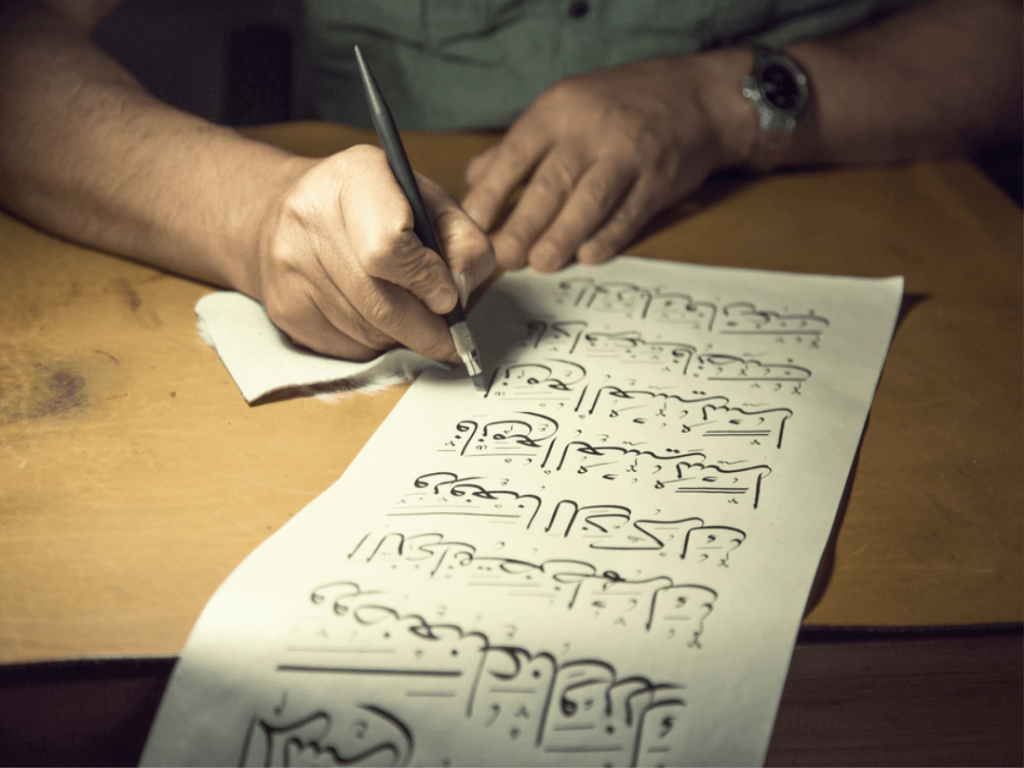Arabic calligraphy, a mesmerizing art form with roots stretching back centuries, holds a place of profound significance in Islamic culture and beyond. More than just beautiful writing, it’s a testament to the power of language, spirituality, and artistic expression. This article explores the rich history of Arabic calligraphy, tracing its evolution, highlighting its key styles, and celebrating the masters who shaped its course.
Origins and Early Development
The story of Arabic calligraphy history begins with the Arabic script itself, derived from the Nabataean alphabet. While the script existed before Islam, it was the rise of Islam in the 7th century that truly propelled its artistic development. As the Quran, the holy book of Islam, spread, the need to preserve and beautify its words led to the emergence of calligraphy as a revered art form.
- Early scripts like Al-Jazm laid the foundation.
- The Kufic script, originating in Kufa, Iraq, became the first major style, characterized by its angular and geometric forms. It was widely used for early Qurans and architectural inscriptions.
The Golden Age and the Rise of Cursive Scripts
The Abbasid era (750-1258 CE) marked a golden age for Arabic calligraphy. During this period, significant advancements were made in standardizing and refining the script.
- Ibn Muqla (886-940) revolutionized calligraphy by establishing precise rules and proportions, a system still used today.
- Ibn al-Bawwab (d. 1022) further refined these principles, bringing elegance and balance to cursive scripts.
- Yaqut al-Musta’simi (d. 1298) is credited with innovations like cutting the reed pen at an angle, enhancing the beauty of the script.
This era saw the rise of cursive scripts like Naskh, which became the standard for transcribing books and the Quran due to its legibility and flowing style. Other important scripts developed during this time include:
- Thuluth: Known for its large, bold, and ornamental style, often used in architectural inscriptions and titles.
- Muhaqqaq and Rayhani: Elegant scripts used for Quranic texts.
Regional Styles and Influences
As Islam spread across vast geographical regions, Arabic calligraphy evolved into diverse styles, reflecting local tastes and artistic traditions.
- In Persia, Nasta’liq emerged as a flowing and elegant script, particularly suited for poetry.
- The Ottoman Empire developed distinctive styles like Diwani, a decorative and cursive script used for official documents.
Key Styles of Arabic Calligraphy
Here’s a brief overview of some of the most prominent Arabic language calligraphy styles:
- Kufic: Angular, geometric, and monumental.
- Naskh: Round, legible, and widely used for books.
- Thuluth: Bold, curved, and often ornamental.
- Nasta’liq: Flowing, elegant, and popular in Persian calligraphy.
- Diwani: Cursive, decorative, and Ottoman in origin.
- Ruq’ah: A simpler and faster cursive script for everyday use.
Famous Calligraphers Through History
Many masters have contributed to the legacy of the history of calligraphy. Some notable figures include:
- Ibn Muqla (886-940): The father of proportional calligraphy.
- Ibn al-Bawwab (d. 1022): Refined and perfected cursive scripts.
- Yaqut al-Musta’simi (d. 1298): A master of various scripts and a highly influential figure.
- Sheikh Hamdullah (1436–1520): Developed the Ottoman style of calligraphy.
- Hafiz Osman (1642–1698): Renowned for his mastery of the Thuluth script.
- Mustafa Rakim (1757–1826): A significant figure in Ottoman calligraphy.
Arabic Calligraphy Today
Arabic calligraphy continues to thrive as a vibrant art form. While traditional techniques are still practiced, contemporary artists are exploring new avenues, blending calligraphy with modern art and design. This Islamic calligraphy history is a living tradition, constantly evolving and inspiring.
Ready to explore the beauty of the Arabic language beyond calligraphy? Visit us at www.kaleela.com to discover a wealth of resources designed for non-native speakers. Take your learning journey to the next level – download the Kaleela Arabic learning app today and unlock a world of interactive lessons and cultural insights!



